| |
|
One Week
Whirlwind Road Trip |
|
Northern East Coast of the USA |
|
The 5 Boroughs of New York City |
|
Monday - August 14th, 2017 |
|
Brooklyn Chinatown
Down the Neighborhood's Central Corridor
Eighth Avenue - for about 28 Blocks |
| Most tourists make a beeline for the Manhattan Chinatown, but there
is also a hidden gem in Brooklyn worth exploring as well. It is actually
one of the fastest growing Asian communities outside of China, with
34,218 Chinese residents. |
|
Brooklyn Chinatown Location |
|
Brooklyn Chinatown
Two Buddhist Temples |
|
Xi Fang Temple
5101 8th Avenue, Brooklyn New York
Buddhist Pure Land |
|
Temple Opened in 2000 to Serve the Growing Chinese
Population. |
|
Pure Land Buddhism is a branch of
Mahayana Buddhism
And one of the 'Most Widely Practiced Traditions' |
|
Jiu Hua Zen
Temple
4115 8th Ave.
Brooklyn, New York, 11232 |
|
Friendly Grandmaster at this Temple |
|
Guardian Deity at the Entrance |
|
Jiu Hua Zen Temple
Main Altar |
|
NY Tao Teh Benevolent Association of
America
Chinese Taoist Society |
|
At "Lucky Eight" . . . the Green Dragon
Society Dined
Walnut Shrimp Superb - Excellent Sea Food |
|
Brooklyn Chinese American
Association
5002 8th Ave, Brooklyn, NY 11220 |
|
Live & Fresh Seafood Market |
|
Brooklyn Chinatown
after
Dark |
|
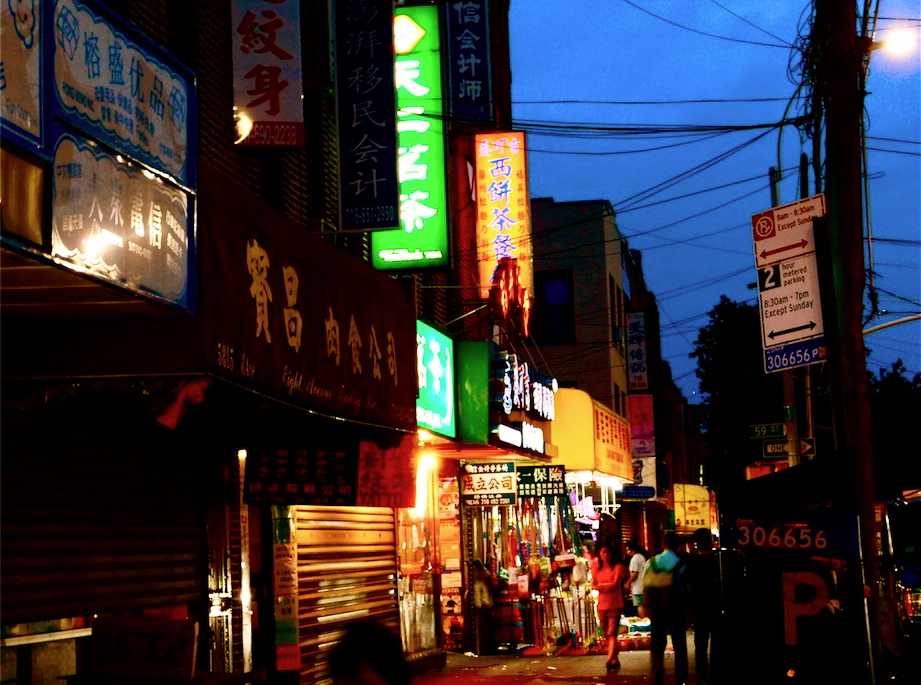
|
New York Elevated Train Station -
Stained Glass Art |
|
|
Tuesday - August 15th, 2017 |
|
Metropolitan Museum of Art
1000 5th Avenue
New York City, New York |
| Metropolitan Museum of Art - Is truly gigantic! With nearly
two million works of art spanning more than 5,000 years, it is one of
the world's largest and finest museums. The Metropolitan Museum of Art
is a universal museum, wherein every category of art in every known
medium from every part of the world during every epoch of recorded time
is represented, and thus available for contemplation or study; not in
isolation, but in comparison with other times, other cultures, and other
media. |
|
Chinese Ming Scholar's Retreat
Reproduction |
|
Hanuman Conversing |
Self Explanatory |
|
Chamunda
Horrific Destroyer of Evil |
Ganesha
Good Luck Deity |
|
Buddha Seated in Meditation |
|
Shiva, Uma and Son Skanda |
|
Manjushri Bodisattva of Transcendent
Wisdom
India (Bengal) |
|
Kuan Yin - Goddess of Mercy |
|
Vajrapani
Thunderbolt Bearing Boddisattva |
|
Vairochana - Transcendent Buddha of
the Center
Pakistan . . . circa 9th Century |
|
Maitreya - Buddha of the Future
Afghanistan . . . circa 7th-8th Century |
|
Guardian Lions
Northern China . . . circa 6th Century |
|
Arhat (China)
Liao Dynasty . . . circa 1000
(above & below) |
|
These life-size sculptures are part of a group of
16 figures that have been known in the West since 1913. |
|
Guardian (Tian Wang)
Ming Dynasty . . . circa 17th Century |
|
Buddhist Maitreya
He Who is to Incarnate |
|
God of Wealth in Military Aspect
Ching Dynasty . . . circa Early 18th Century |
|
Ancient Asiatic
Copper & Bronze Weapons |
Ancient Near East - Art encompasses a vast area, from the
eastern Mediterranean region to the Indus Valley and from the Central
Asian steppe to the southwestern Arabian peninsula. Extending from the
eighth millennium B.C. (Neolithic Period).
An "Art of the Elite" - It illustrated both natural and
supernatural beings and forces. The function of the art glorified the
state and its leaders, and communicated with the Gods. Gestures, garment
patterns, and specific facial features reflected the concepts and ideals
of the society, and gave ancient Near Eastern works their distinctive
character and power. |
|
Ancient Near East
Copper & Bronze Weapons |
|
Ancient Cypriot
Copper & Bronze Edged Weapons |
|
Assyrian Sickle Sword
Bronze . . . circa 1300 B.C. |
|
Arab Islamic & Indian Subcontinent
Mughals 1526 to Ottoman Empire 1923 |
|
Descended from Genghis Khan (Died 1227) and Timur
(Died 1404), the first Mughal Emperor was Babur.
Babur's grandson established dominion over large parts of the Indian
subcontinent. |
|
Ottoman Empire
Circa . . . 1299 to 1923 |
|
The Ottomans created a powerful empire, eventually
controlling most of the Mediterranean coastline.
At its peak the Ottoman Empire comprised Anatolia, the Balkans, and the
Caucasus.
But also Syria, Iraq and Arabia, Egypt and much of North Africa. |
|
From
the
Metropolitan Museum of Art's
Collection of Masterpiece Paintings |
|
Hagar in the Wilderness by Camille
Corot
circa 1835 |
|
Perseus
Holding the Decapitated Head of Medusa |
|
Metropolitan Museum of Art
Arms & Armor Collection |
|
Helm for Foot Combat . . . circa
1500 |
|
Italian Burgonet . . . circa 1560
Etched Steel and Gilt |
|
Elegant Shape & Beautiful Decoration
Helmet was 'Made in Italy' under 'French Influence' |
|
Field Armor of Henry 8th of England |
|
Steel - Blackened, Etched and Gilt
w/Leather
Weight 50 pounds 8 oz
Italian . . . circa about 1544 |
|
This impressive armor was made for King Henry VIII
(reigned 1509-47).
At the time it was made the King was toward the end of his life, when he
was overweight and crippled with gout. |
|
It was probably worn by King Henry during his last
military campaign, the 'Siege of Boulogne' in 1544
which he commanded personally in spite of his infirmities. |
|
Tray of Jeweled Daggers
Turkish Ottoman Period |
|
Tuesday - August 15th, 2017 |
| New York City's Chinatown - The largest Chinatown in the
United States and the site of the largest concentration of Chinese in
the western hemisphere, is located on the lower east side (see map
above). |
| A stroll through downtown's famed Chinatown would be incomplete
without a visit to the colorful, massive Mahayana Buddhist Temple,
seated at the foot of the Manhattan Bridge. |
|
Mahayana Buddhist Temple
133 Canal Street, New York City, 10002 |
|
The Temple is Guarded by Gilded
Lions |
|
The Tallest Buddha in New York City
Sits in the Mahayana Temple of Chinatown |
|
Fit for its Giant Buddha
The Mahayana Temple is also the Largest Buddhist
Temple in New York City |
| Prints depicting pivotal events of the Indian Mystic's life cover
the surrounding walls while tables in front of the sculpture provide a
place for families to make offerings in memory of dead relatives. |
|
International Society Of Nun Yen
Sutra
20 Eldridge Street, New York Chinatown, New York |
|
Trans World Buddhist Association
7 E. Broadway, New York |
|
Huang Da Xian Taoist Temple
20 Bowery, New York |
|
Taiwanese Kuomintang (KMT)
16 Mott St, New York |
|
Fu Jian Xi Bian Qiao Lian
Association |
|
Green Dragon Society
Dined at the 'East Seafood Restaurant' in Manhattan's Chinatown
The Seafood is Live at Market Prices |
|
East Seafood Restaurant
Caters to Large Groups |
|
Taiwan Pork Chop House - 3 Doyers Street, New York |
|
Nom Wah Tea Parlor - 13 Doyers Street, New York
Opened as a Tea Parlor and Bakery in 1920 |
|
Chinatown Map (Old Chinatown)
Mott Street, Pell Street & Doyers Street |
|
Remaining examples of early tenement buildings, on
Doyers Street, in New York's Chinatown.
Built around 1900. When the Chinese moved in, the tenements had no
running water or sewerage. |
|
Doyers Street
New York Chinatown |
In the heart of Chinatown, in the New York City borough of
Manhattan, it is one block in length and has a sharp bend in the middle.
It is a strange little stretch called Doyers Street, one of the few
streets in Manhattan bent at a nearly 90-degree angle and one of the
bloodiest streets in American history!
Whether it was because of bullets or hatchets, Doyers Street was
literally stained red during its most violent years, earning the street
its immortal nickname: “The Bloody Angle.” |
|
Doyers Street
Intersection at Bowery, Chatham Square and Division Street |
| This winding path at just a block long, Doyers Street, begins at
Pell Street, makes a 90 degree turn, then meanders the rest of the way
down to the intersection of Bowery, Chatham Square and Division Street. |
|
Chinese Tuxedo Restaurant at 2
Doyers Street
Circa 1901 |
|
Doyers Street is a Former Footpath with a 90-degree
Bend |
|
Down Doyers toward Pell Street
Approaching the "Bloody Angle" |
| Early in the 20th Century - The bend in Doyers Street became
known as "The Bloody Angle" because of numerous shootings among the Tong
Gangs of Chinatown that lasted into the 1930s. Hatchets were frequently
used, leading to the creation of the expression, "Hatchet Man".
In 1994, law enforcement officials said that more people died violently
at the "Bloody Angle" than at any other street intersection in the
United States. |
|
Doyers Street in Chinatown . . .
circa 1909 |
|
Also known as New York's "Murder Alley"
It was, and is, an ideal place for ambush, as the turn is very abrupt. |
|
Turning the Corner at the Bloody
Angle |
| “The police believe, and can prove it so far as such proof is
possible, that more men have been murdered at the Bloody Angle than any
other place of like area in the world,” wrote Herbert Asbury in
The Gangs of New York. |
|
Walking toward
Pell Street at the End of the Block |
|
Corner of Doyers And Pell Streets |
|
Corner of Doyers And Pell Streets
Looking Toward Mott Street |
|
Corner of Doyers And Pell Streets
Looking Down Doyers Street
15 Pell Street |
|
Intersection of Doyers and Pell
Street . . . circa 1900
Looking Down Doyers Street
15 Pell Street |
| Around 1900: "In all New York City, there is not a more
disreputable street than Pell Street nor a more forbidding cow-path than
Doyers Street." Together, these lanes were "cesspools of immorality vile
enough to bring a curse upon the entire community." |
|
Around 1909 in New York Chinatown
At 11 Mott Street - There was a Brothel Owned by the Infamous Tom
Lee |
|
Mott Street - New York Chinatown |
|
Hop Kee Restaurant - 21 Mott Street, New York |
|
Late-night, cash-only Chinese spot serving
traditional Cantonese in a no-frills basement location. |
|
Peking Duck House - 28 Mott Street, New York |
|
Silkroad Place Cafe - 30 Mott Street, New York |
|
New York
Manhattan Chinatown
After Dark |
|
Rong Jie Co - 6 Pell Street, New
York |
|
Joe's Shanghai - 9 Pell Street, New
York |
|
Famous Sichuan Restaurant - 10 Pell
Street, New York |
|
Glow Day Spa - 12 Pell Street, New
York |
|
Yeah Shanghai Deluxe - 50 Mott
Street, New York |
|
Chinatown Gift Center - 55 Mott
Street, New York |
|
Shang Hai Cuisine - 69 Mott Street,
New York |
|
New York Chinatown Sculpture |
|
Little Italy and Chinatown Border Each Other |
Little Italy - Is the pocket-neighborhood reminder of the
great wave of Italian immigration which came through New York
City starting in the late 1870s. This was the home of a densely packed,
lively neighborhood of pushcarts, cheese shops, barber shops and organ
grinders, populated by thousands of new immigrants in dilapidated old
tenements.
The area has some of New York’s oldest still-operating shops, from
Ferrara Bakery to Di Palo’s. But there’s also a dark side to this
neighborhood, memories of extortion plots by the Black Hand and a
perpetual presence of organized crime.
The present-day Little Italy is completely charming but constantly
shrinking. How long can the neighborhood survive in the face of a
growing Chinatown and the threats of gentrification? |
|
Casa Bella
127 Mulberry Street, New York |
|
Time for some coffee, tea and desert
at the end of a long day in Manhattan. |
|
|
Wednesday - August 16th, 2017 |
|
Queens Chinatown Location |
|
Queens Chinatown
2nd Biggest Chinatown of the Big Apple |
|
Main Street and Roosevelt Avenue is
the Heart of the Flushing Chinatown
Consisting of all Nationalities but Predominantly Chinese and
Koreans |
|
True Buddha Diamond Temple of New
York |
|
The True Buddha Teachings are
Tibetan
Temples were Established in Taiwan
From Taiwan the True Buddha School has Spread to America |
|
True Buddha Temple's Back Yard |
|
Furnaces for Fire Ceremonies
Burning of Prayers & Offerings to Heaven |
|
Beautiful True Buddha Temple
Entrance Altar |
|
Temple Grandmaster Laine Che |
|
Main Altar
Some Close-up Shots |
|
Mandala Wall Mural
(Close-up Below) |
|
Han Ma Um Zen Center of New York
144-39 32nd Ave.
Flushing, New York, 11354 |
|
Murals of the Buddha's Life |
|
Malay Restaurant
135-17 40th Road, Flushing, New York |
|
Not Much to Look At
We Are Uncertain of the Name!
Is it "New Restorant Malaysia"
The Menu Lists it as - "Malay Restaurant, Inc." |
|
But the food is 100 percent superb
traditional Malaysian cuisine.
The Green Dragon Society recommends the "Drunken Shrimp"
(A wine shrimp soup loaded with Ginseng and other
medicinal herbs) |
|
Queens (Flushing) Chinatown
After Dark |
|
Thursday - August 17th, 2017 |
|
Coney Island is Located in the
Southernmost Part of Brooklyn
Address: 1208 Surf Avenue |
|
Discovered in 1609 by Dutch explorer Henry Hudson, Coney
Island eventually became an amusement resort at the beach. Coney Island
was home to Sea Lion Park, the first enclosed amusement park, which
opened in 1895. Coney Island became famous for having several of the
best-known amusement parks in the world. |
|
The Original Nathan's . . . since
1916 |
|
Coney Island - Luna Park at Night
Circa . . . 1920s |
|
Nathan's Hotdogs on the Boardwalk
The Green Dragon Society
Lunched at Nathan's |
|
3 miles of sandy beaches, sunny
skies and rolling waves . . .
The beach was far from capacity, but it was a weekday visit. |
|
Coney Island - Historical Postcards |
|
Tornado Rollercoaster |
Dreamland . . . circa 1904 - 1911 |
|
Luna Park |
Coney Island - Sideshow . . . circa 1913 |
|
Coney Island - Steeplechase Park . . . circa 1936 |
|
Luna Park - Witching Waves |
|
Thursday - August 17th, 2017 |
| Times Square - Is in Midtown Manhattan, New York City, formed
by the intersection of Seventh Avenue, 42nd Street, and Broadway. Times
Square is also the center of the Theatre District. |
|
Ripley's "Believe It or Not" Museum |
|
Collections of Shrunken Heads and Such
At $70.00 per person there were no long lines, even in Times Square. |
|
These lobby statues are
disappointing.
Ripley's isn't what it used to be! |
|
Ripley Pictures are From the Lobby |
|
New York Police Department |
|
Lieutenant Colonel Francis P. Duffy
Catholic Priest |
|
Times Square
Nude Picture Posers |
|
Thursday - August 17th, 2017 |
|
Empire State Building
350 5th Ave, New York, NY 10118 |
|
It is a short walk from Times Square to the Empire
State Building. |
| The Empire State Building - Is a 102-story skyscraper located
on Fifth Avenue between West 33rd and 34th Streets in Midtown,
Manhattan, New York City. |
|
Empire State Building History |
|
1930: March 17th - Construction of the Empire State
Building begins.
1931: May 1st - Empire State Building completed and officially opens.
1933: March 2nd - The movie 'King Kong' is released in New York City.
1945: July 28th - A B-25 Mitchell Bomber was lost in fog over Manhattan.
The Bomber slammed into the 78th floor of the Empire State Building,
which was then the tallest building in the world.
The Empire State building stood as the world's tallest building for
nearly 40 years from its completion in early 1931. |
|
"King Kong" Display at the Empire
State Building
80th Floor Observatory |
|
King Kong Motion Picture Poster
(1933) |
| The Empire State Building - Had only been finished a few
years before, when in 1933 it played a pivotal role in the climax of the
film King Kong. In motion pictures nothing like it had been
previously achieved in special affects. The Empire State Building was
after all, the tallest building on earth, and King Kong fell from the
top, the 102nd floor observatory's roof. New Yorkers went wild! |
|
80th Floor Observation Level |
|
Observatory
Manhattan Views |
|
The Empire State Building is still taller than the
ones around it and the view is magnificent. |
|
Looking Towards Lower Manhattan |
|
Towards the Hudson River & Upper New
York Bay |
|
Upper New York Bay (Zoom In)
Towards Ellis Island and Liberty Island
(Statue of Liberty - (Far Left at Mid Photo) |
|
Toward the Hudson River
(above & below) |
|
It's 216 miles between New York City
(Manhattan) and Boston Massachusetts.
It was a 5 hour drive with traffic. |
|
Friday - August 18th, 2017 |
|
Boston's Historic District |
|
Where did the 'Sons of Liberty' plot
the American Revolution?
Raise a glass at the oldest bar in Boston? |
|
Boston's early Patriots - Loved their brew and
hatched some of their best plots against the Redcoats while quenching
their thirst in their favorite local watering holes. Who knows, you
might even sit in the very same spot where Paul Revere or George
Washington raised a glass.
Boston's most historic sites cluster along streets laid out in Colonial
times . . . in other words, they're narrow, twisting, and congested. |
|
Bell In Hand Tavern
45 Union St, Boston, Massachusetts 02135 |
| The Bell in Hand - Is the longest continuously operating
tavern in the United States, having been built in 1795 by Boston's
retired Town Crier. The Town Crier's job was to shout the big news
across town, and the original proprietor of the Bell in Hand shouted
about the Boston Tea Party, the Declaration of Independence, the
impending Battle of Bunker Hill, and of course, the defeat of the
British. |
|
Union Oyster House
41 Union St, Boston, Massachusetts 02108 |
|
An historic eatery serving chowder & other New England
seafood standards since 1826. |
|
Friday - August 18th, 2017 |
|
Green Dragon Society
Enjoyed the Evening Meal
at the
Green Dragon Tavern |
|
We recommend the Corned Beef and
Cabbage.
But not the Lobster! |
Green Dragon Tavern - Was a public house used as a tavern and
meeting place located on Union Street in Boston's North End.
Green Dragon Tavern dates back to 1654 - From that perspective,
it is the oldest historic Boston bar.
The Original Green Dragon Tavern - Wasn't exactly in the same
location where you'll find it today, although it was nearby . . . the
tavern moved around a few times back in the early days, and anyway the
original building no longer even exists. |
|
Green Dragon Tavern
Original Building on Union Street in Boston
Revolutionary War Period |
|
Green Dragon Tavern
11 Marshall St, Boston, Massachusetts 02108 |
|
Today the Green
Dragon Tavern has taken on more of an Irish flavor. |
|
"May you be poor in misfortune, rich in blessings, slow
to make enemies, quick to make friends, but rich or poor, quick or slow,
may you know nothing but happiness, from this day forward."
John J. Somers, Proprietor |
|
Intersection
Creek Square & Marshall Street |
|
Green Dragon Tavern History |
The Green Dragon Tavern - Has a long and rich history,
playing an important part in the freedom of Boston during the War of
Independence. Established in 1654 The Green Dragon Tavern was a favorite
haunt of Paul Revere and John Hancock (who’s brother lived next door!).
Indeed, as has been ratified by Daniel Webster, the famous historian, it
was in the Green Dragon Tavern that the plans for the invasion of
Lexington and Concorde were overheard thus starting the famous ride of
Paul Revere.
Coined by Daniel Webster as the "Headquarters of the Revolution",
the original Green Dragon Tavern served as the general meeting place and
think tank for events that would eventually shape our great nation to
this day. Over two centuries ago, Samuel Adams, Dr. Joseph Warren, Paul
Revere and other notable Founding Fathers met in secret at the Green
Dragon Tavern to discuss the events of their day and organize calls to
action. Used as both a tavern and meeting space, the Sons of Liberty,
met to assess and respond to issues faced by a growing nation and its
people under tyrannical rule.
These meetings led the Sons of Liberty to host one of the most
famous tea parties in history on December 16, 1773, the Boston Tea
Party! These secret meetings also led to the departure of Paul
Revere on April 18, 1775, from the Tavern, on his famous midnight ride
to Lexington and Concorde to warn Patriots that the "British are
coming" to commandeer their weapons and capture John Hancock, Sam
Adams and other militia leaders. Revere also initiated the preplanned
warning system of lighting lamps, "One if by land, two if by sea."
The Green Dragon Tavern was acquired by the St. Andrews Lodge of
Freemasons from a private owner around 1766. Once located on Union
Street in Boston's North End, the original Green Dragon Tavern was
demolished in 1854. Little is actually known of the Tavern's interior
facade. Tavern's of that time were often dimly lit with a central
fireplace, low ceilings and steep staircases with narrow steps. It is
believed that Green Dragon Tavern was named after the copper dragon that
adorned its main entry, which as copper does so over time when exposed
to the elements, turned patina green in color. |
|
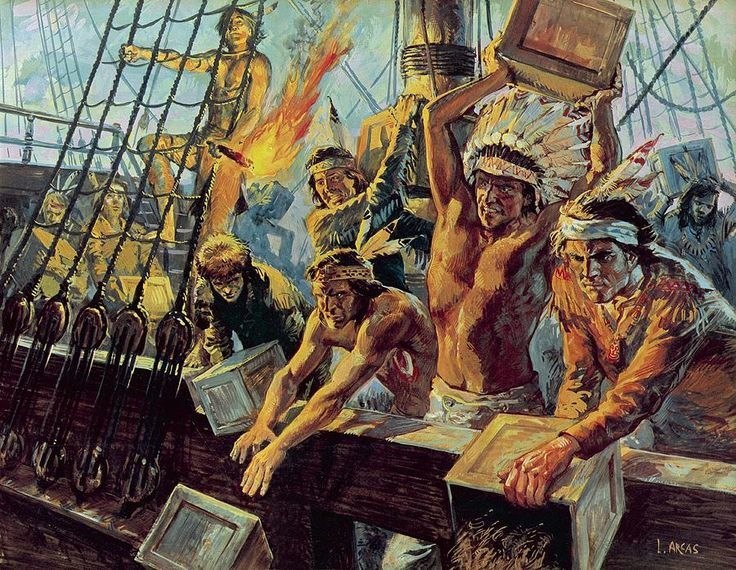 |
|
A protest by the Sons of Liberty (dressed as
Indians) against a tax on British tea. |
|
Green Dragon Tavern
"Home of the Boston Tea Party"
Meeting Place of Masons |
* A Note of History
. . . from the Green Dragon Tavern
The Green Dragon Tavern has a rich history since it first opened in
1657. During the time of the American Revolution, the Green Dragon
Tavern was a "Hotbed" meeting place for Boston Revolutionaries. It was
deemed "The Headquarters of the Revolution" by Samuel Adams, Daniel
Webster and Paul Revere. The 'Sons of liberty' held meetings there and
discussed plans for resistance to the acts of the British Crown and
Parliament.
The idea of the British to capture Sam Adams and John Hancock (and seize
the powder at Concord) were discovered at the Green Dragon Tavern. Sam
Ballard, a 13 year old, overheard two British officers discussing the
plans, and then alerted the tavern's landlord. The landlord informed the
'Committee of Safety'.
They concealed a spy in the room where the British held their councils
and based their plan for Paul Revere's ride. On the night of the 18th,
they carefully guarded the tavern to keep the committee's plan
confidential. Joseph Warren sent Sam Ballard to Paul Revere's house with
the historic message. The Mechanics ratified the Constitution at the
Tavern. Several political clubs sprang into prominence at this time,
including the North End Caulkers Club, from which we get "Caucus". This
group was responsible for the disposition of the tea and the ensuing
'Boston Tea Party'.
In the 1600's the Green Dragon Tavern attracted America's most noble and
courageous leaders, and today it continues to attract interesting
figures. |
|
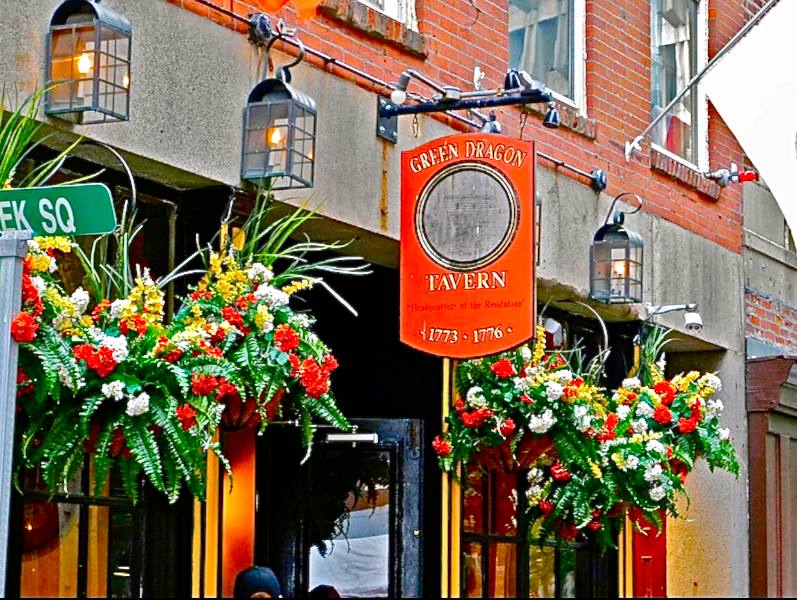 |
|
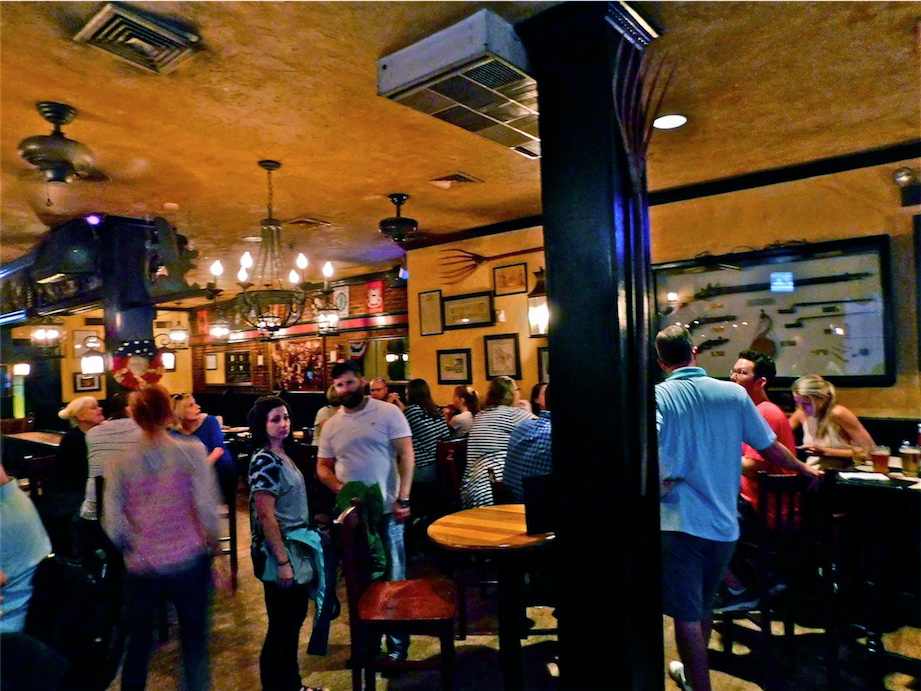 |
|
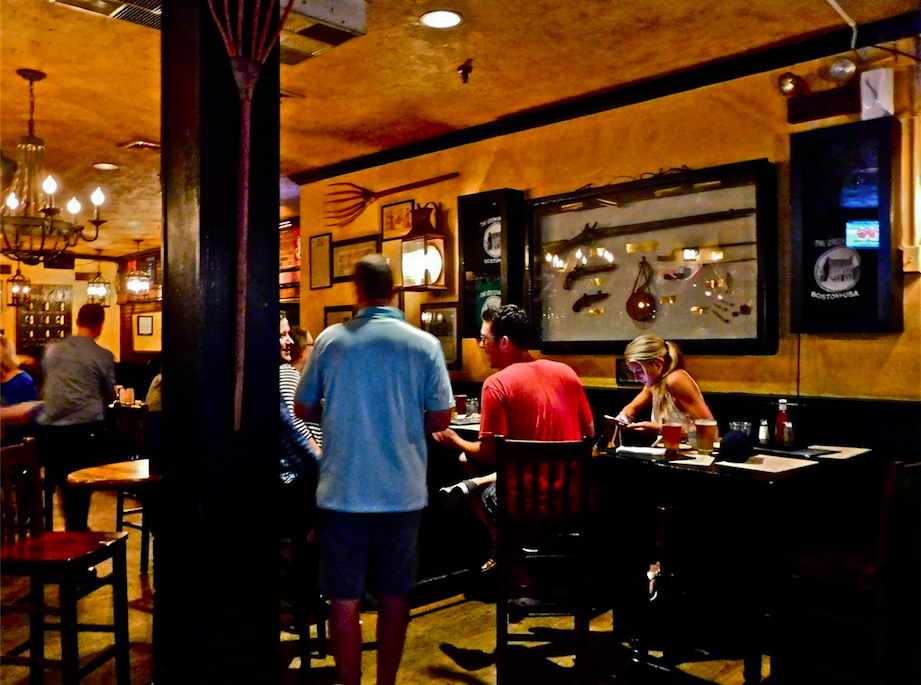 |
|
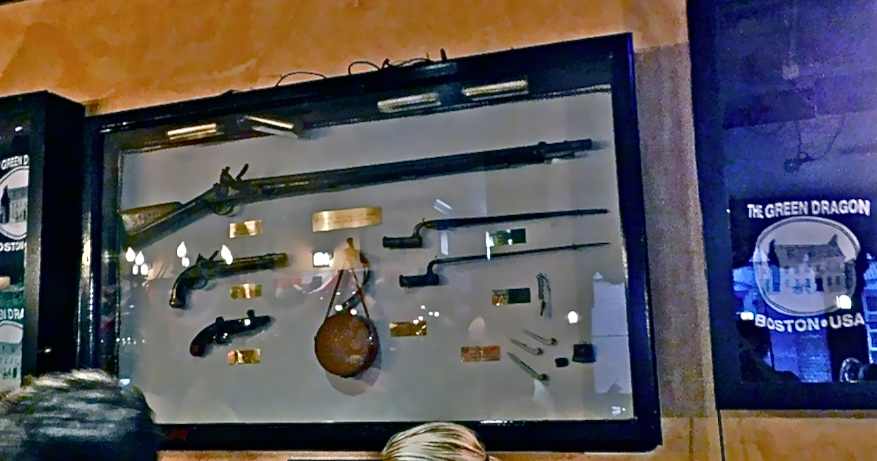 |
|
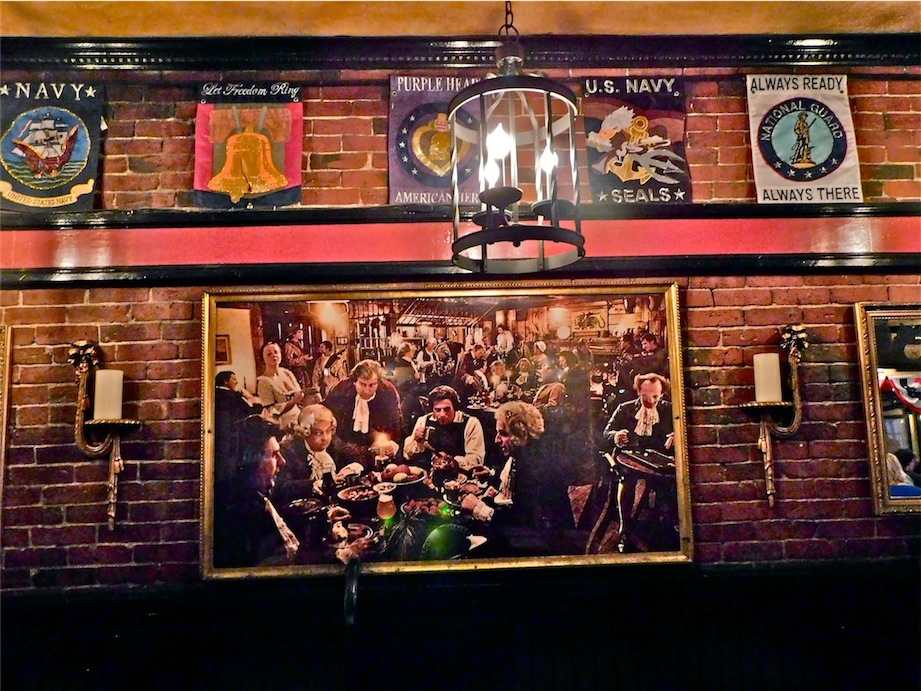 |
|
Quincy Market Building in Faneuil
Marketplace |
|
Filming a Hollywood Movie in
Chinatown |
|
Saturday - August 19th, 2017 |
|
It is a 20 Minute Ride from Boston
to Cambridge, Massachusetts |
|
New England Style Architecture in
Cambridge
Colonial, Georgian, and Federal to Greek Revival
and Victorian |
| Harvard University - Is a private Ivy League research
university in Cambridge, Massachusetts, established in 1636, whose
history, influence, and wealth have made it one of the world's most
prestigious universities. |
|
Harvard Yenching Institute |
|
Adolphus Busch Hall
Interior Views |
|
Adolphus Busch Hall Foyer |
|
Close-up Views
Hand Carved Woodwork |
|
Adolphus Busch Hall
Garden |
|
Saturday - August 19th, 2017 |
|
The Peabody Museum
of
Archaeology and Ethnology |
|
11 Divinity Avenue
Cambridge, Massachusetts |
|
From towering Native American totem poles and Maya
sculptures to finely woven textiles and everyday utensils, the Peabody
Museum is among the oldest archaeological and ethnographic museums in
the world with one of the finest collections of human cultural history
found anywhere. |
|
Peabody Museum at Harvard |
|
Aztec Temple Chair
(Side Views) |
|
Ethnographic Indigenous Weapons |
|
Arts of War Exhibition
Artistry in Weapons across Cultures |
|
An Anthropological Look at Weapons
of War as Objects of Art |
|
The Peabody Museum of Archaeology and Ethnology at
Harvard
Explores Centuries of Weapons from Around the World that Double as Works
of Art |
|
Arts of War Exhibit
Ends
October 18th, 2017 |
|
Some of the decorative traditions represented were
developed for aesthetic purposes, such as the gemstones embedded in a
Balinese blade or prehistoric Nazca spear-thrower decorated with a
carved cat.
Others were more utilitarian. For instance, Western Australian wooden
shields were grooved with zig-zagging patterns to disorient their foes,
not dissimilar from the later “Dazzle” camouflage on World War I ships.
One of the exhibition’s most intriguing displays features body armor
from the Kiribati on the southern Pacific Gilbert Islands. The armor is
formed from coconut fiber, and accompanied by a spiky helmet made from a
whole puffer fish and a sword inset with shark teeth, an intimidating
example of transforming the natural world around you into an outfit of
war.
As the Peabody is among the world’s oldest anthropology museums, the
pieces on view are impressively global, coming from every continent
aside from Antarctica (which has yet to have its first war). It’s also
interesting to see these objects (many, like the Tlingit armor,
collected in the 19th century when the colonizing cultures were amassing
the very weapons they were rendering obsolete) reframed in a wider
consideration of human ingenuity in the face and service of violence.
There are only a couple of items related to peace in the exhibition, one
being a wampum belt from Northeastern Ontario, the other a pipe-tomahawk
that is believed to have belonged to Red Cloud of the Oglala Lakota. As
an indigenous leader in the 19th century, when his people were being
relocated onto reservations after battles with the US Army, the shape of
the pipe as a bludgeoning weapon seems appropriate to its complex place
in time. |
|
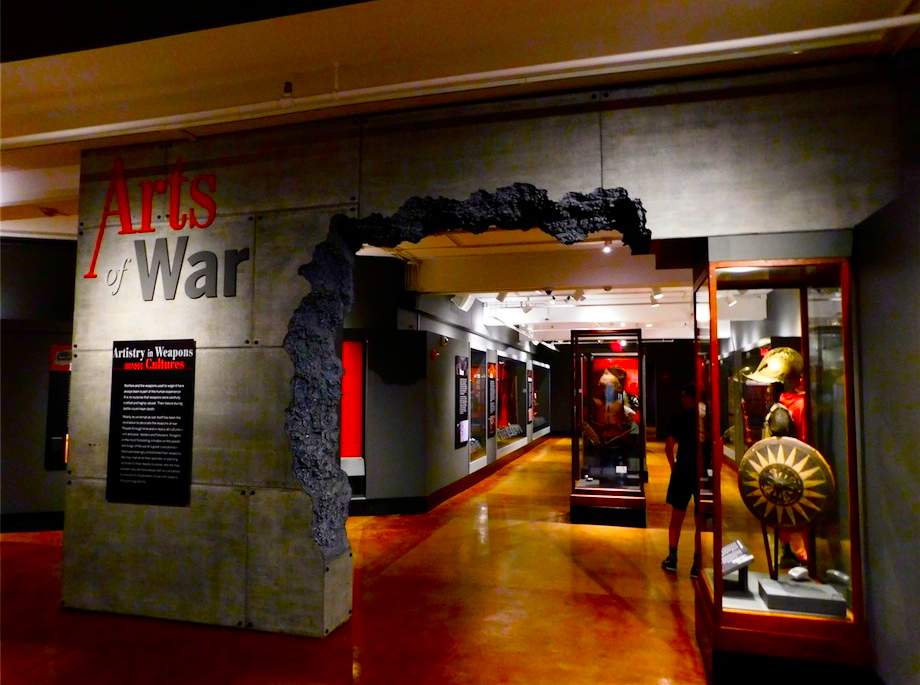 |
|
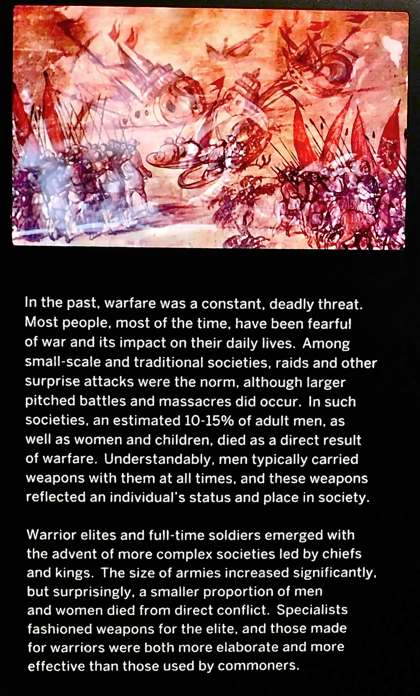 |
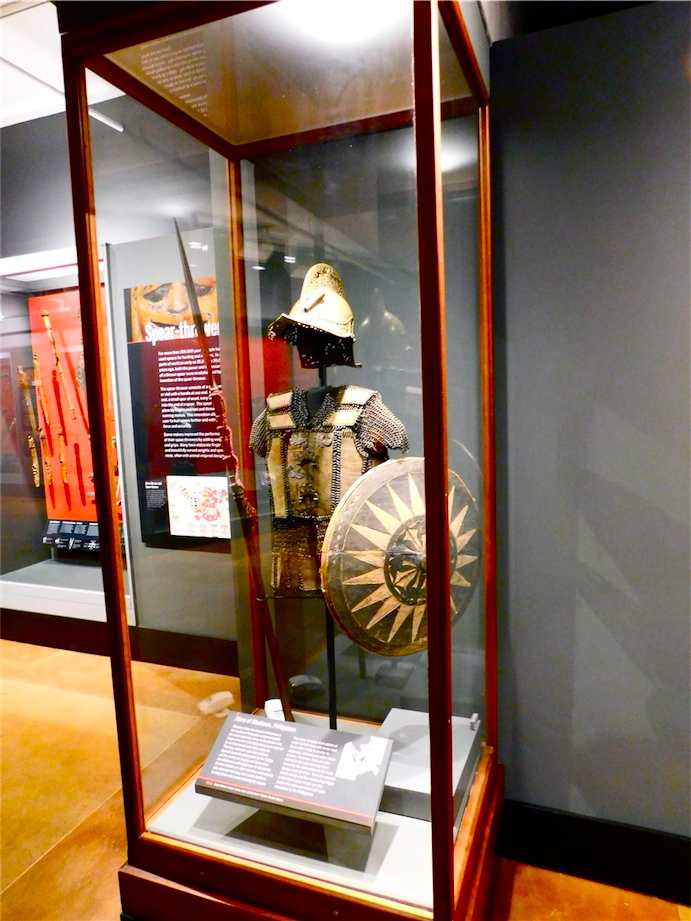 |
|
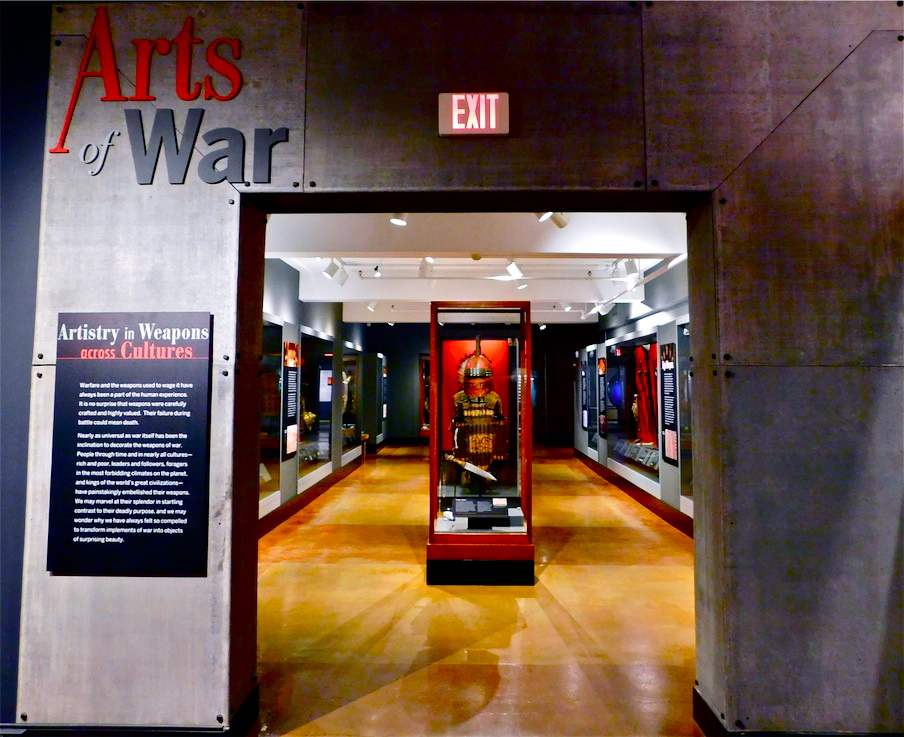 |
|
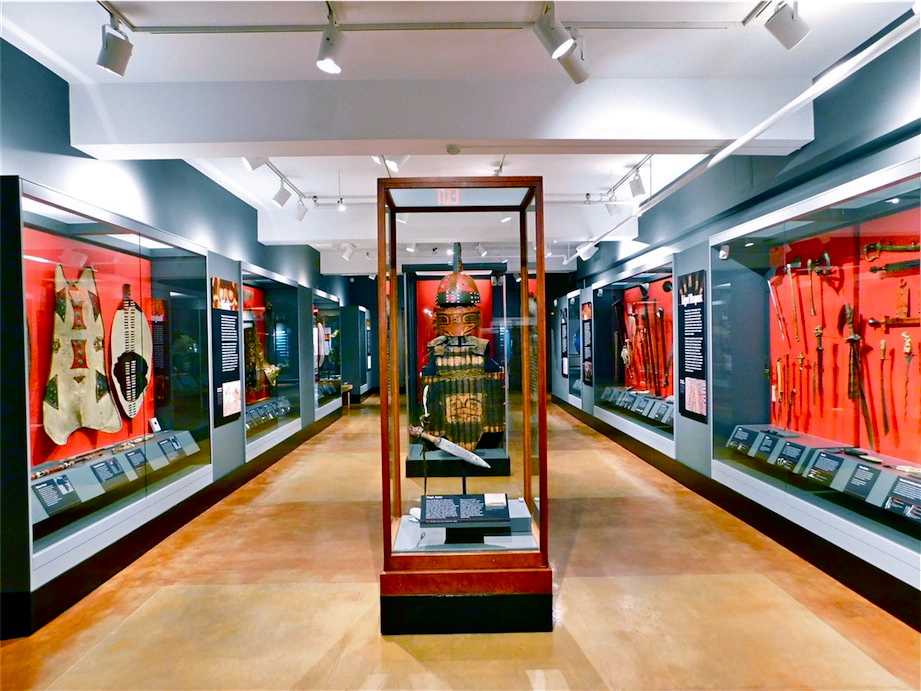 |
|
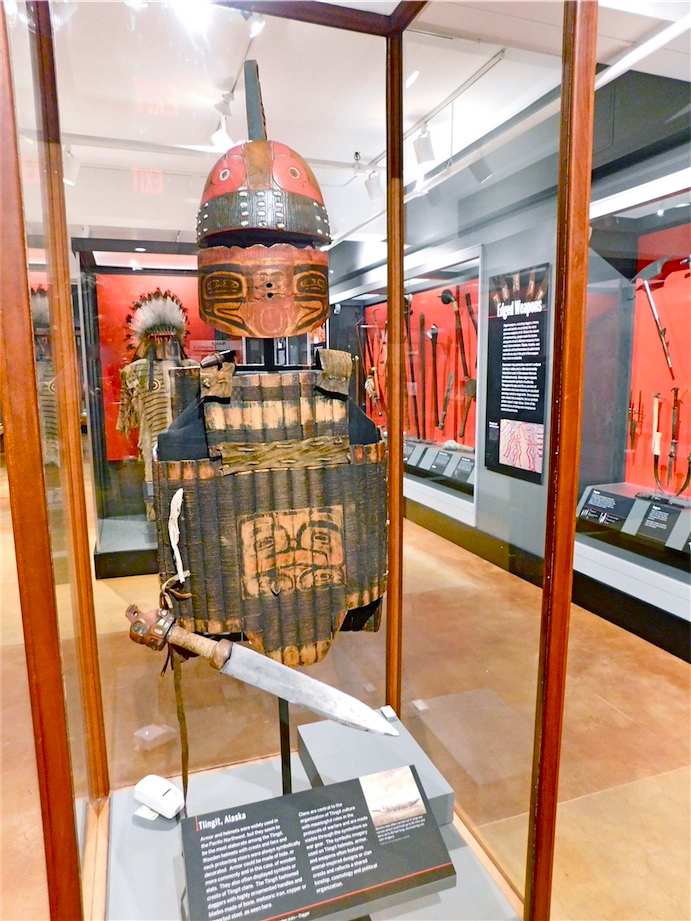 |
|
North American Indian Headdress |
|
Head Piece Display (Opposite View) |
|
Wooden/Stone/Bone Weaponry Display
Case |
|
|